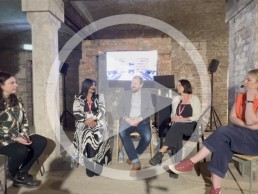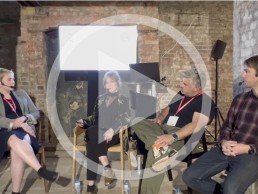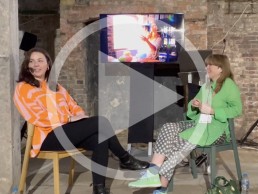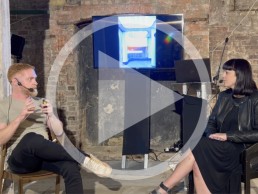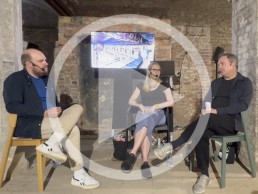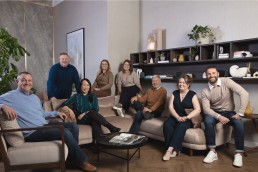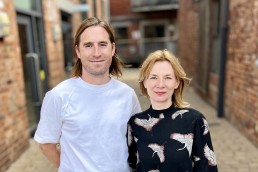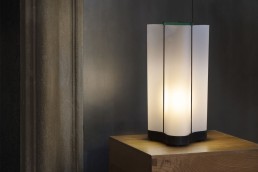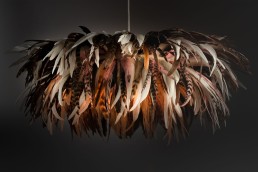[d]arc thoughts @ CDW - Working with Residential Lighting
As part of Clerkenwell 2023, darc magazine hosted a [d]arc thoughts programme with the lighting and design industry as part of the Light exhibition in the House of Detention.
The panel of experts look at what exceptional lighting looks like within the home; how residential projects differ from working on commercial projects and what designers should be aiming for when it comes to the 'right light' within a residential environment.
Speakers: Raminder Virdi - Lutron; Marcus Steffen - MS Lighting Design; Susie Rumbold, Founder and Creative Director - Tessuto; Lizzie Webster - Fraher and Findley.
lutron.com
mslightingdesign.co.uk
tessuto.co.uk
fraherandfindlay.com
[d]arc thoughts @ CDW - The Lighting Police
As part of Clerkenwell 2023, darc magazine hosted a [d]arc thoughts programme with the lighting and design industry as part of the Light exhibition in the House of Detention.
The educational international platform The Lighting Police invites everyone to participate in an interactive fun session focusing on designed and not designed light, highlighting important elements that we take for granted in our daily life and not noticing how they are affecting our health and well-being. The session will be moderated by four members of the advisory board of the project and at the end of the session, we are certain that everyone will leave empowered to start observing more and aiming for better lighting conditions in their lives!
Speakers: Gary Thornton - Nulty; Inessa Lomas - ARUP; James Poore - JPLD; Kael Gillam - Hoare Lea
[d]arc thoughts @ CDW - The Wave Collection, Curiousa
As part of Clerkenwell 2023, darc magazine hosted a [d]arc thoughts programme with the lighting and design industry as part of the Light exhibition in the House of Detention.
Having been awarded ‘Best Decorative Lighting Product’ at this year’s [d]arc awards for the Wave Collection, Sarah Cullen, Editor at [d]arc media, sits down with designer and founder Esther Patterson to delve deeper into the collection’s design process, her inspiration, and how an ethical approach to production and manufacturing is vital to her ethos.
[d]arc thoughts @ CDW - Project Focus, Yotel Vega, Glasgow
As part of Clerkenwell 2023, darc magazine hosted a [d]arc thoughts programme with the lighting and design industry as part of the Light exhibition in the House of Detention.
Lighting designer and founder of Artin Light, Luke Artingstall sits down with Helen Ankers, Managing Editor at d]arc media, to discuss the intricacies of his lighting design for the Yotel Vega Hotel project in Glasgow; from brief to concept, to challenges and the end result - we uncover it all.
[d]arc thoughts @ CDW - Project Focus, Battersea Power Station, London
As part of Clerkenwell 2023, darc magazine hosted a [d]arc thoughts programme with the lighting and design industry as part of the Light exhibition in the House of Detention.
After opening to great fanfare in late 2022, [d]arc media's Editor Matt Waring steps inside the newly renovated Battersea Power Station and speaks to Clementine Fletcher-Smith and Philip Rose of Speirs Major about the landmark’s monumental new lighting design.
SpaceInvader announces appointments and promotions to strengthen team
(UK) - SpaceInvader Founder John Williams has announced a number of new appointments and promotions at the Manchester-based interiors agency that will strengthen and boost the firm’s senior management team.
The changes involve the appointment and promotion of two new Associate Directors and five new Associates across the different parts of the studio.
"As we emerge properly out of the pandemic and face the future with a burgeoning order book," John Williams comments, ‘it was definitely the moment to make a strategic investment in the future of the agency by appointing a strong new level of senior management. These key appointments will help take the company forward as we continue expanding from our solid workplace design base and into more hospitality and developer-residential schemes. We are bringing new talent into the company, as well as rewarding and promoting some of the strongest players in the existing team, whilst also expanding their roles to help the studio stay ahead of the game on some of the major challenges the industry is facing, particularly around sustainability and technological change."
Former Associates Nathan Lindley and Sarah Dabbs have now been made Associate Directors, having first joined SpaceInvader in 2015 and 2019 respectively. Lindley's new responsibilities will include "overseeing the perfection of our technical delivery across all projects as well as nurturing some of our key client partnerships, such as Manchester City", whilst Dabbs' will cover "the management of processes and systems, including sustainability-reporting on projects, as well as providing an increased presence in the management of client relationships".
The five new Associates include Interior Designers Imogen Woodage, who joined SpaceInvader in 2015 and Regina Cheng, who came on board in 2017, as well as Graphic and Branding Designer Jenny Crossland, who joined in 2019 and Principal Designer Tad Kolakowski, who joined in 2020. "We are one of the only dedicated interiors agencies, certainly the only one we know of, with a dedicated Principal Designer on its books. This brings our in-house knowledge to another level," adds Williams.
The final new Associate is a new hire – Jon Waldron, an Interior Designer with a background in high-end residential and marine, who previously ran his own practice and will bring expertise in managing larger and more complex projects through to delivery.
Two new appointments at director level for Istoria Group
(UK) - Istoria Group, the Bristol-based collective of creative agencies, has announced two new Group-level appointments.
Silka Mitchell is the new Group Creative Director, while Bryn Isaac has been named Group Financial Director.
Istoria Group, which became a B Corp last autumn, is comprised of exhibition and events specialists Ignition, known for being sustainable pioneers and as recipients of The Queen’s Award for Enterprise in Sustainable Development 2020-25; hospitality and retail designers Phoenix Wharf, known for its work for regional operators such as Yeo Valley, The Bristol Loaf, Better Food and Spicer + Cole, as well as for national retailer SpaceNK and Apprentice winner Harpreet Kaur - and purposeful digital transformation experts Tiny Spark, whose virtual exhibit expertise during the pandemic helped Istoria Group survive the period’s challenging business conditions.
"Creative Director at Group level was an important role to fill and it was proving difficult to find the right candidate," says Sam Rowe, Istoria Group’s CEO. "We were delighted therefore to be introduced to Silka Mitchell, who brings not only top London agency experience as a former Director of both Brinkworth and Neu Architects but also broad international experience, delivering projects in the commercial and public realms across Europe, Western Asia and China. Silka is German-born and has lived and worked in both Germany and the UK. Her languages and multi-disciplinary, cross-sector experience will bring fresh energy and a new level of design sophistication to our studio."
Silka Mitchell adds: "My ambition is to help Istoria Group grow and develop an even stronger 3D identity, becoming known for creative originality and excellence. I look forward to unlocking the further potential of the talented studio and to bringing in the next generation of talent to complement my vision. I further hope to instil creative leadership, inspiration and motivation and improve processes and the working environment through creative intervention and dialogue. I’m really excited to be working with a business with such a wealth of knowledge, strong ethics and a truly sustainable ethos."
New Group Financial Director Bryn Isaac is Bristol-born and bred and brings great expertise in and knowledge of regional markets and business to his role. Isaac joins Istoria Group after eight years as Financial Director of We Are Fearless, an integrated marketing agency specialising in sports, culture and music sponsorship and partnerships. He has also worked with both start-up and group-owned agencies previously, including TBWA/Worldhealth, Momentum Worldwide and Given London. For Istoria Group, Isaac will provide the financial lead within the business across all the agencies in the Group and will manage financial planning covering both opportunity and risk.
"I aim to use my experience of young and dynamic businesses to update processes and modernise systems at Istoria Group to help all parts of the business become more efficient and productive," Bryn Isaac comments. "I’m looking forward to working alongside the leadership team to plan future strategic business growth, both operationally within the internal team and externally as the business grows in size."
"I am delighted that Bryn has joined us as Finance Director," adds Rowe. "Bryn’s relevant knowledge and experience are vital as we continue our ambitious plans to grow and develop sustainable creative solutions for clients. As a B Corp, our ambition is to grow in the right way – with the right clients and the right team in place. These two new senior appointments are a huge leap in the right direction."
[d]arc thoughts, Chelsom 2023
[d]arc media's Managing Editor Helen Ankers chats with Will Chelsom, Managing Director of Chelsom in the UK. The British lighting brand launched its new Edition 28 collection at Clerkenwell Design Week 2023, along with three new in-house sub-brands; Home, Restore and Studio C.
Nemo Lighting opens new showroom in Copenhagen
(Denmark) - Nemo Lighting opens a new showroom in Copenhagen on the occasion of 3daysofdesign and presents for the first time in the Nordics the entire 'Masters' collection, a unique selection of lamps designed by 20th-century masters such as Le Corbusier and Charlotte Perriand.
Nemo continues its developing trend by adding a showroom in order to display and interact with architects and professionals in the vibrant Copenhagen.
On display for the first time are a new design by Le Corbu, the Lampe Cabanon, and a unique project by Perriand, the Lampe de Bureau. The exhibition will also be complemented by a series of original sketches and historical drawings.
Considered one of the main precursors of Modern Architecture, Le Corbusier remains the most important figure in the complex landscape of 20th-century architecture, while Charlotte Perriand stands out for revisiting the concept of design and its aesthetic values, reviving contemporary design through timeless, iconic and authentic objects that bear witness to modern times.
The Masters collection, realised in collaboration with the Le Corbusier Foundation and the Charlotte Perriand Archives, is based on original sketches and unique hand-drawn prototypes. The collection showcases the extraordinary vision and design sensibility of these two figures in modern architecture and design.
LAMPE CABANON | Le Corbusier
A preview presentation of a previously unpublished project and a philological journey to comprehend the foundations of Le Corbusier's product philosophy.
In 1952, on the shores of the French Riviera, Le Corbusier built "Cabanon": the absolute archetype of essential living. The project, executed according to the rules of the Modulor, is found just a stone’s throw away from the sea and served as a refuge for the architect in his final years. Lampe Cabanon, named after the inspired microcosm, represents a symbol of architecture, design, production, and essential living. The lampshade, made from tracing paper that the architect used, was crafted from a wartime artefact - a mortar shell carrier - found on French beaches. The lamp, for which numerous sketches and designs exist, represents a moment of rebirth in the post-war world.
Tala achieves B Corp
(UK) - British lighting brand Tala achieves B Corp.
Tala scored 89.7 in its first B Impact assessment, exceeding the industry-certified average of 87.1 and becoming only the sixth UK-based lighting company to join the B Corp community. The score addresses the entirety of a business’ operations and covers five key impact areas: Governance, Workers, Community, Environment and Customers.
Tala was founded on the premise that "good design can help mitigate climate change". Since its inception in 2015, it have promoted the vital role that efficient, low-energy LED technology can play in the global move to zero carbon, and are proud to have played a small part in making this technology ubiquitous across the globe.
Looking ahead to the next step in its journey, the brand is working in harmony with its founding sustainability values, and can now collaborate and align with over 6000 like-minded B Corp businesses to offer greater clarity and engagement to the community.
There are currently more than 6,200 B Corps in 161 industries and 89 countries across the globe.
"B Corp is more than a stamp of approval. It is an objective framework for us to build a profitable business that works for both people and the planet. It gives us the language and tools to share our story with the wider world. It raises the bar for us to reach and it helps us to articulate our journey towards becoming the world’s definitive zero-carbon lighting brand. One light at a time," says the brand. "Becoming a B Corp wasn’t easy and the hard work doesn’t stop here. We look forward to achieving an even higher score when we re-certify in 2026."
Registration opens for London Design Fair
(UK) - Registration has now opened for London Design Fair, which is making its return on 21 – 24 September 2023 at the iconic Truman Brewery in the heart of Shoreditch.
New for its 2023 edition and consciously curated by stylist, writer and consultant Roddy Clarke, London Design Fair in collaboration with the UK’s sustainable business community Blue Patch, will present ‘Homes with a Heart’. The area will feature a sustainably styled home that demonstrates there is no compromise on aesthetics when opting for responsibly produced and manufactured products for the home.
The first edition of London Design Fair’s new initiative Design Alumni Pavilion will showcase and support emerging talent within the design community. The exclusive selection of new talents will consist of recent graduates who have recently begun their career within their chosen practice of design. Confirmed exhibitors include Ian Burnell, lamunlamai. Craftstudio, MESEME Studio, Jenna Gillinger, Coleccion Estudio , Samia Hilal and Emily Hatton Surface Design.
The sold-out British Craft Pavilion is an exhibition of high-end crafts, exclusively designed and produced in Great Britain. This exhibition will showcase products from a spectrum of disciplines, with a spotlight on the very best in collectable design. All those exhibiting in this area are presenting work that was designed and produced in the UK with a majority of British materials. Confirmed exhibitors include James Design, Barbara Gittings, Wallpaper by Deborah Bowness, Pamela Print, Remi Dubois Design, LUX Pottery, Jason Lock Wood Turning and Jane Cairns.
London Design Fair has garnered a reputation for being a leading destination during the Festival to discover cutting-edge work and inspiration from across the world. The 2023 edition will once again feature many international pavilions including Made in Sweden (supported by the Swedish Embassy) showcasing a collection of Swedish designers exhibiting work with strong sustainable credentials, including Stamuli and Swedish Ninja. Many other international collections are to be announced over the coming months.
The LDNdesign Talks Theatre will feature an inspiring line-up of industry figures and designers – curated with the support of the design community. LDNdesign Talks Theatre offers four days of talks and workshops specifically targeted at both trade and consumer audiences. The programme will feature sessions curated by partners including Architonic, darc magazine, TrendBible, Mix Interiors, Design Council, BIID, as well as exclusive designer talks and interactive workshops.
This year London Design Fair is also launching a new feature area named the Sustainable Materials Showcase. This is an exclusive selection of materials used and repurposed in an innovative way that contributes towards a global mission to better the environment. The Sustainable Materials Showcase gives London Design Fair exhibitors the chance to show their raw material, shine a spotlight on the material’s environmental credentials, and tell a story about the production process and thought process behind their finished product. Visitors will then be led back to the exhibitors' stand space to see the finished and more polished product.
Register here (tickets are free for trade visitors) here.
Robert Sonneman
Sonneman - A Way of Light celebrates its 60th anniversary, with Robert Sonneman still at the helm leading the studio to success.
darc’s editor, Sarah Cullen, sat down with Sonneman to briefly discuss his history with the brand, but to also discover how the world of lighting and indeed business has evolved over the last six decades.
Born and raised in Manhattan, NYC, Robert Sonneman was fortunate to experience a blend of both public and private education. “Even when very young, if I chose not to show up at school on a winter day, I would often seek the warmth of one of several museums that were accessible along the route,” he reminisces.
Sonneman was also lucky enough to be surrounded by art as a child, and actively encouraged by his father to seek out inspiration in everyday life. “I got to grow up around art,” he says. “Encouraged by my father to explore my early interest in art, I took weekly classes at the art students league as an early teenager. I was always building something, from model aeroplanes to boats to bicycles. But my models were not built to the instructions, even when they were available. Somehow, I always sought out another approach and wanted to build it differently. They often didn’t work the way they were intended to, but I still wanted to do it another way and I guess I still do.”
Sonneman had a brief spell with the Navy before leaving at the age of 19. It was at this point he first found his way to the world of lighting. “I answered an ad for a job in a little shop on Madison Avenue selling European modern lighting and home accessories. The name of the shop was George Kovacs. I was the only employee and when I wasn’t selling or sweeping up, I was figuring out how to make something that a customer might have described from something they liked in the store but wanted it to be different in some way.
“George introduced me to European modernism in architecture and design. His introduction to the straightforward approach to the modern aesthetic and the integrity of minimalism immediately clicked with me and became foundational to my life’s focus and point of view.”
After graduating from Long Island University a few years later, Sonneman opened his first factory, at the age of 22. From there, he took Kovacs to market selling the modern lighting pieces he created. “One of my first designs was the Orbiter, on exhibit at the Museum of Modern Art and when people told me “You’re a great designer,” I thought to myself what’s a designer? But as I pursued my creative path little by little, I realised that a designer is what I was becoming.”
Despite his early successes, Sonneman has gathered a wealth of knowledge and experience through various job roles. “My career has been varied and challenged through several changes, stages, and iterations of experience.
“Almost everything that I have done I did because I didn’t know that I couldn’t.
“Sonneman - A Way of Light was founded because of events that coalesced around a simple idea. When George Kovacs sold his company, I owned the patents and legal rights to the products that I designed for him.
“In 2003, at the urging of the sales reps to go back into manufacturing and at my reluctance to do so, I called David Littman, my long-time friend who immediately came to my studio. In that period, I was designing and licensing products for about six to eight other companies and felt that I would do the same with his companies. David, Sonny Park (Executive Chairman), and I sat in the office to discuss another possible license deal with Hudson Valley. After only a few minutes of David’s thought, he looked at me across the room and said: “Robert I will do this deal with you on one condition and on one condition only: We will manufacture these designs under the Robert Sonneman name, and we will do it as 50-50 partners. I looked across the room at Sonny for her assessment and approval and when she indicated her willingness to go forward, we agreed and launched Contemporary Visions, which matured into Sonneman - A Way of Light.”
Looking back at some of the more significant moments in his career, Sonneman struggles to select standouts as there have been so many. “There were so many significant moments along the odyssey of my career that it is hard, in reflection, to single out which were more important than the others. Sometimes small decisions or happenings led to significant outcomes that proved to be larger, grander, and more impactful than I could have imagined or planned for. But without a doubt, there have been critical inflexion points that changed our destiny. One experience that changed our trajectory was in November 2011. I was sitting in the studio conference room with my partner Sonny and with Nicolas, Vice President of product development. Gazing at the renderings tacked on the wall of the new products that I had designed and were ready for release for a January show, I said: “This line stinks. It’s just not good, not important, and not the best we can do and it’s my fault”.
“I worked through that weekend reimagining what lighting should be about and what was important enough to bring to market and the realisation that it was not about decorative configurations but rather about what we could achieve with the new technology of LED. It changed everything. We had to become a technology-driven company.
“I did the conceptual drawings and a week later the solid works models were in the factory. Nicolas and Christian, our engineer, were on a plane to make the concepts work and to build them in time for our January show. They did it and we opened to the “oohs and aahs” of our dazzled customers. The very first sale of our new design was from a national department store that placed an order for one million dollars.
“The refusal to accept mediocrity and the courage to admit and accept responsibility for who we were and what we should be could have easily been lost in the pressure of the moment and the acceptance of the mundane.
“The entire direction of the company changed, and we began to build out our team and our vision for the future toward a single objective: Illumination from the art of Technology.”
Sonneman has been fortunate to witness and play a role in the changes of product design over the last few decades, witnessing the evolution of LED technology and manufacturing efficiency.
“When I began designing lighting products in the 1960s, lighting was looked upon as an accessory to the interior design and less as a focal point defining the utility of a space. The creative process during that time was all manually executed, supported by hand-drawn sketch concepts and mechanical drawings. Even our study models were hand-crafted in metals, wood, and paper.
“In its early stages, designing lighting was often the contrivance of creating decorative or modern forms, to support shades and glass shapes, to hold electric light bulbs in various positions. The functional side of lamp and fixture design was defined by the target markets of the client. The idea of providing an illuminating object was much more about its aesthetic appearance than about achieving lighting performance per illuminating standards.
“In my years of designing home products and small appliances, the focus was to provide functionality repackaged to project a technical or performance advancement. Make it more modern, make it sleeker and make it look like the latest in innovation in the small appliance space.
“As a modernist, I designed furniture in the context of an architecturally modern period or school, i.e., Mackintosh, Bauhaus, Prairie, or Functionalism to name a few. It was an interesting experience that I enjoyed but it did not hold my attention with the same passion and inquisitiveness that I experience designing lighting. It is a marriage of art and design with the innovation of the new frontier of technology.
“Today we continue to draw quick sketches in sketchbooks but immediately go to 2D and 3D CADD to develop and visualise the creative concepts modelled with details with 3D printing and other digital renderings and modelling.
“I am a modernist driven by simplicity and functionality designed from an intelligent point of view. My style is rooted in the pathos of modern functionality of the mid-20th century and has grown with the evolution of modern architecture and design through the last six decades. I have remained committed to my minimal approach and to executing design with simplicity and the integrity of purpose. As Modernism evolved and morphed into genres of style, my vision and my approach expanded but I still adhere to the core principles of Functionalism. Certainly, technology has altered what is now possible but if anything, I believe that it has allowed us to execute innovative design with even more functionality and simplicity.”
When asked what some of the most frustrating elements of working with design are, Sonneman describes any creative process as “driven by the passion of the creator engaged in the struggle to innovate creatively.”
“Imagining a vision for a specific purpose or from the abstract space of experience always challenges the creator to think differently. Design does not usually appear in its resolved state but rather in stages of development that the creator moves through to evolve as an approach to realising a vision.
“With the literally thousands of designs that I have created over the past 60+ years, I have developed an approach to the process that I have found effective but certainly no less challenging. I don’t look at a reference of another competitive product while I am trying to conceptualise a project. I look at other categories of other products constantly but when I sit to draw, I want to see nothing but a white page and I let my memory and my imagination bring lines to paper. There are lots of times that are frustrating and unresolved but there are also times when new imagery emerges from my imagination. I always seek a point of view and when I find it, the rest is an easy exercise in developing and resolving that approach.
“Advancing technology in many disciplines will change the development and experience of lighting product design. Integration into the architectural utility, form and design will continue to evolve the unity of lighting as a system within the presence of building environments. Conceptually, the imagination of the built environment will include lighting as a dynamic component to the environmental experience of a space.
“More so than ever, you will see and experience what you light.”
Sonneman believes that technological developments, alongside science, can be enablers of art and design. “Technology has enabled a dramatic shift offering a new universe of imagination and possibilities.
“Electronically generated illumination is a wave in the spectrum of energy and as such we can control, direct, and manage illumination as a component in a broad-based integrated system of energy.
“Coupled with the performance, efficiency, size and optical options, technology has changed the design, application, and utility of illumination.
“If there is a downside to technology impacting design, we have not found it. All the applications that we have applied to the design of our LED products have proven superior in performance. We have found technology helps us expand and improve our product design and development. If we use high-quality diodes and high-quality controls, we have found the shift to LEDs a positive enabler of our product offering.”
When asked whether the lighting industry has moved in a direction he anticipated over the years, Sonneman references the developments in international manufacturing. “In the 1960s, lighting was less about illumination technology and more about the fabrication of materials like metals, glass, ceramics, and stone. Lighting was locally made in factories with manufacturing resources all available in the New York area. As regulations like OSHA took over, and labour unions took hold, the costs of operations and materials rose past the market’s acceptance. Manufacturers began to move west to California for Mexican labour and to European manufacturers in Spain, Italy, Hungary, and Poland. As time passed, Taiwan became a manufacturing centre with great skills and low prices. Over the next 20 years, manufacturing began to move to Hong Kong and then to mainland China where it is now centred with extensive facilities and a huge supporting infrastructure. We are now on the cusp of seeing the potential for change again, but the lighting industry has yet to locate into a next collective region specifically and has spread out into numerous locations in Asia and around the globe.
“Today, lighting is about packaging technology for performance, efficiency, and integration into building systems. Form factors have changed to accommodate technology and creative potential has expanded in shape and scale with new materials and new fabricating processes.”
The business world has also evolved drastically over the course of Sonneman’s career, so much so that he cannot summarise it in its entirety. “The profound changes in the world of business over the last 60 years is too overwhelmingly huge in scope for me to address but I can certainly identify some of the evolutionary changes in doing business in our segment of the lighting industry.
“Aside from the overarching transactional digital technology that is universal to all business, lighting’s changes occurred in all the areas from conception to manufacturing and from sales and distribution through a local independent dealer network to online access to the world’s lighting products.
“Six decades ago, most lighting manufacturers fabricated their products in-house. Today, there are some who still do but many more that use foreign facilities to build their products. Lighting now exists in a global market, accessible online.
“Professionally, educationally, and creatively, we have grown and evolved as an industry to encompass new insight, technology, illuminating capabilities and applications that are expanding the world of lighting across new frontiers.
“Despite the universally dramatic changes and advancements, many things about the lighting industry remain in place and are consistently similar to the practices of past generations. We still rely on people to work with and build relationships with showrooms, architects, lighting designers, specifiers, and national clients. Great people with product knowledge, experience, talent, and commitment are still the essential element of success within the lighting industry.”
“Lighting is universally essential, creatively challenging, complex, and infinitely interesting. My father’s advice was “Find something that you love to do and do it well. Allow your passion to drive your ambition. It will become your life’s work and define your identity.”


